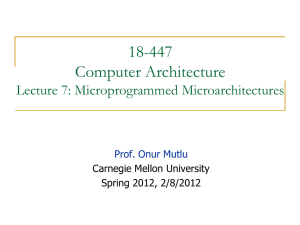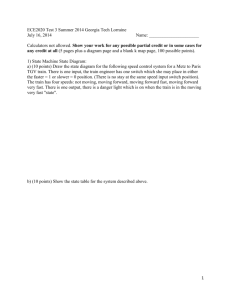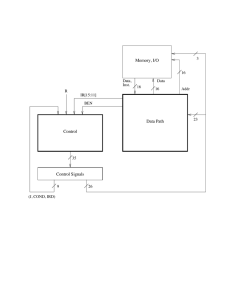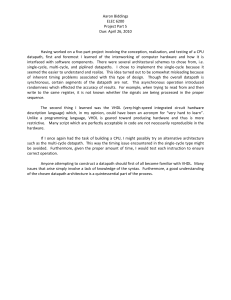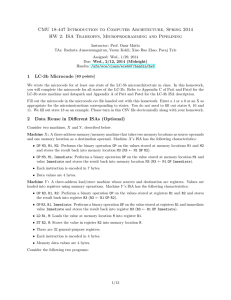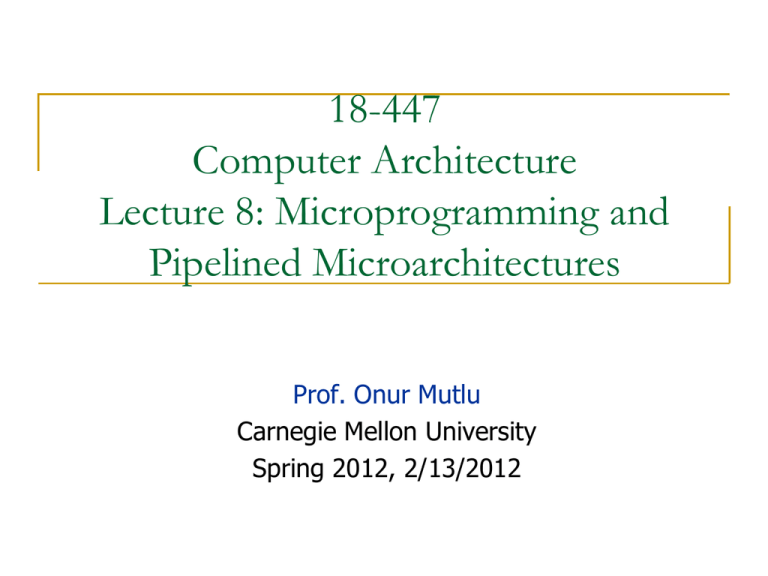
18-447
Computer Architecture
Lecture 8: Microprogramming and
Pipelined Microarchitectures
Prof. Onur Mutlu
Carnegie Mellon University
Spring 2012, 2/13/2012
Reminder: Homeworks
Homework 2
Due today
ISA concepts, ISA vs. microarchitecture, microcoded machines
Homework 3
Will be out tomorrow
2
Homework 1 Grades
Number of Students
35
30
25
20
15
10
5
0
50
60
70
80
90
100
110
Grade
Average
Median
Max
Min
100
103
110
55
Max Possible Points
110
Total number of students
56
3
Reminder: Lab Assignments
Getting your Lab 1 fully correct
We will allow resubmission once, just for the purposes of
testing the correctness of your revised code (no regrading)
Lab Assignment 2
Due Friday, Feb 17, at the end of the lab
Individual assignment
No collaboration; please respect the honor code
Lab Assignment 3
Will be out Wednesday
4
Reminder: Extra Credit for Lab Assignment 2
Complete your normal (single-cycle) implementation first,
and get it checked off in lab.
Then, implement the MIPS core using a microcoded
approach similar to what we are discussing in class.
We are not specifying any particular details of the
microcode format or the microarchitecture; you should be
creative.
For the extra credit, the microcoded implementation should
execute the same programs that your ordinary
implementation does, and you should demo it by the
normal lab deadline.
5
Readings for Today
Pipelining
P&H Chapter 4.5-4.8
6
Readings for Next Lecture
Required
Pipelined LC-3b Microarchitecture Handout
Optional
Hamacher et al. book, Chapter 6, “Pipelining”
7
Announcement: Discussion Sessions
Lab sessions are really discussion sessions
TAs will lead recitations
Go over past lectures
Answer and ask questions
Solve problems and homeworks
Please attend any session you wish
Tue 10:30am-1:20pm (Chris)
Thu 1:30-4:20pm (Lavanya)
Fri 6:30-9:20pm (Abeer)
8
An Exercise in Microcoding
9
A Simple LC-3b Control and Datapath
10
18, 19
MAR <! PC
PC <! PC + 2
33
MDR <! M
R
R
35
IR <! MDR
32
RTI
To 8
1011
BEN<! IR[11] & N + IR[10] & Z + IR[9] & P
To 11
1010
[IR[15:12]]
ADD
To 10
BR
AND
DR<! SR1+OP2*
set CC
1
0
XOR
JMP
TRAP
To 18
DR<! SR1&OP2*
set CC
[BEN]
JSR
SHF
LEA
LDB
STW
LDW
STB
1
PC<! PC+LSHF(off9,1)
12
DR<! SR1 XOR OP2*
set CC
15
4
MAR<! LSHF(ZEXT[IR[7:0]],1)
To 18
[IR[11]]
0
R
To 18
PC<! BaseR
To 18
MDR<! M[MAR]
R7<! PC
22
5
9
To 18
0
28
1
20
R7<! PC
PC<! BaseR
R
21
30
PC<! MDR
To 18
To 18
R7<! PC
PC<! PC+LSHF(off11,1)
13
DR<! SHF(SR,A,D,amt4)
set CC
To 18
14
2
DR<! PC+LSHF(off9, 1)
set CC
To 18
MAR<! B+off6
6
7
MAR<! B+LSHF(off6,1)
3
MAR<! B+LSHF(off6,1)
MAR<! B+off6
To 18
29
MDR<! M[MAR[15:1]’0]
NOTES
B+off6 : Base + SEXT[offset6]
PC+off9 : PC + SEXT[offset9]
*OP2 may be SR2 or SEXT[imm5]
** [15:8] or [7:0] depending on
MAR[0]
R
31
R
DR<! SEXT[BYTE.DATA]
set CC
MDR<! SR
MDR<! M[MAR]
27
R
R
MDR<! SR[7:0]
16
DR<! MDR
set CC
M[MAR]<! MDR
To 18
To 18
R
To 18
24
23
25
17
M[MAR]<! MDR**
R
R
To 19
R
State Machine for LDW
10APPENDIX C. THE MICROARCHITECTURE OF THE LC-3B, BASIC MACHINE
Microsequencer
COND1
BEN
R
J[4]
J[3]
J[2]
IR[11]
Ready
Branch
J[5]
COND0
J[1]
Addr.
Mode
J[0]
0,0,IR[15:12]
6
IRD
6
Address of Next State
Figure C.5: The microsequencer of the LC-3b base machine
State 18 (010010)
State 33 (100001)
State 35 (100011)
State 32 (100000)
State 6 (000110)
State 25 (011001)
State 27 (011011)
unused opcodes, the microarchitecture would execute a sequence of microinstructions,
starting at state 10 or state 11, depending on which illegal opcode was being decoded.
In both cases, the sequence of microinstructions would respond to the fact that an
instruction with an illegal opcode had been fetched.
Several signals necessary to control the data path and the microsequencer are not
among those listed in Tables C.1 and C.2. They are DR, SR1, BEN, and R. Figure C.6
shows the additional logic needed to generate DR, SR1, and BEN.
The remaining signal, R, is a signal generated by the memory in order to allow the
C.4. THE CONTROL STRUCTURE
11
IR[11:9]
IR[11:9]
DR
SR1
111
IR[8:6]
DRMUX
SR1MUX
(b)
(a)
IR[11:9]
N
Z
P
Logic
BEN
(c)
Figure C.6: Additional logic required to provide control signals
R
IR[15:11]
BEN
Microsequencer
6
Control Store
2 6 x 35
35
Microinstruction
9
(J, COND, IRD)
26
10APPENDIX C. THE MICROARCHITECTURE OF THE LC-3B, BASIC MACHINE
COND1
BEN
R
J[4]
J[3]
J[2]
IR[11]
Ready
Branch
J[5]
COND0
J[1]
0,0,IR[15:12]
6
IRD
6
Address of Next State
Figure C.5: The microsequencer of the LC-3b base machine
Addr.
Mode
J[0]
.M
LD A R
.M
LD D R
. IR
LD
. BE
LD N
. RE
LD G
. CC
LD
.PC
Ga
t eP
Ga C
t eM
Ga DR
t eA
Ga L U
t eM
Ga ARM
t eS
HF UX
PC
MU
X
DR
MU
SR X
1M
AD U X
DR
1M
UX
AD
DR
2M
UX
MA
RM
UX
AL
UK
MI
O.
E
R. W N
DA
TA
LS .SIZ
HF
E
1
J
nd
D
Co
IR
LD
000000 (State 0)
000001 (State 1)
000010 (State 2)
000011 (State 3)
000100 (State 4)
000101 (State 5)
000110 (State 6)
000111 (State 7)
001000 (State 8)
001001 (State 9)
001010 (State 10)
001011 (State 11)
001100 (State 12)
001101 (State 13)
001110 (State 14)
001111 (State 15)
010000 (State 16)
010001 (State 17)
010010 (State 18)
010011 (State 19)
010100 (State 20)
010101 (State 21)
010110 (State 22)
010111 (State 23)
011000 (State 24)
011001 (State 25)
011010 (State 26)
011011 (State 27)
011100 (State 28)
011101 (State 29)
011110 (State 30)
011111 (State 31)
100000 (State 32)
100001 (State 33)
100010 (State 34)
100011 (State 35)
100100 (State 36)
100101 (State 37)
100110 (State 38)
100111 (State 39)
101000 (State 40)
101001 (State 41)
101010 (State 42)
101011 (State 43)
101100 (State 44)
101101 (State 45)
101110 (State 46)
101111 (State 47)
110000 (State 48)
110001 (State 49)
110010 (State 50)
110011 (State 51)
110100 (State 52)
110101 (State 53)
110110 (State 54)
110111 (State 55)
111000 (State 56)
111001 (State 57)
111010 (State 58)
111011 (State 59)
111100 (State 60)
111101 (State 61)
111110 (State 62)
111111 (State 63)
10APPENDIX C. THE MICROARCHITECTURE OF THE LC-3B, BASIC MACHINE
COND1
BEN
R
J[4]
J[3]
J[2]
IR[11]
Ready
Branch
J[5]
COND0
J[1]
0,0,IR[15:12]
6
IRD
6
Address of Next State
Figure C.5: The microsequencer of the LC-3b base machine
Addr.
Mode
J[0]
The Microsequencer: Some Questions
When is the IRD signal asserted?
What happens if an illegal instruction is decoded?
What are condition (COND) bits for?
How is variable latency memory handled?
How do you do the state encoding?
Minimize number of state variables
Start with the 16-way branch
Then determine constraint tables and states dependent on COND
20
The Control Store: Some Questions
What control signals can be stored in the control store?
vs.
What control signals have to be generated in hardwired
logic?
i.e., what signal cannot be available without processing in the
datapath?
21
Variable-Latency Memory
The ready signal (R) enables memory read/write to execute
correctly
Example: transition from state 33 to state 35 is controlled by
the R bit asserted by memory when memory data is available
Could we have done this in a single-cycle
microarchitecture?
22
The Microsequencer: Advanced Questions
What happens if the machine is interrupted?
What if an instruction generates an exception?
How can you implement a complex instruction using this
control structure?
Think REP MOVS
23
The Power of Abstraction
The concept of a control store of microinstructions enables
the hardware designer with a new abstraction:
microprogramming
The designer can translate any desired operation to a
sequence microinstructions
All the designer needs to provide is
The sequence of microinstructions needed to implement the
desired operation
The ability for the control logic to correctly sequence through
the microinstructions
Any additional datapath control signals needed (no need if the
operation can be “translated” into existing control signals)
24
Let’s Do Some Microprogramming
Implement REP MOVS in the LC-3b microarchitecture
What changes, if any, do you make to the
state machine?
datapath?
control store?
microsequencer?
Show all changes and microinstructions
Coming up in Homework 3
25
Aside: Alignment Correction in Memory
Remember unaligned accesses
LC-3b has byte load and byte store instructions that move
data not aligned at the word-address boundary
Convenience to the programmer/compiler
How does the hardware ensure this works correctly?
Take a look at state 29 for LDB
State 17 for STB
Additional logic to handle unaligned accesses
26
Aside: Memory Mapped I/O
Address control logic determines whether the specified
address of LDx and STx are to memory or I/O devices
Correspondingly enables memory or I/O devices and sets
up muxes
Another instance where the final control signals (e.g.,
MEM.EN or INMUX/2) cannot be stored in the control store
Dependent on address
27
Advantages of Microprogrammed Control
Allows a very simple datapath to do powerful computation by
controlling the datapath (using a sequencer)
Enables easy extensibility of the ISA
High-level ISA translated into microcode (sequence of microinstructions)
Microcode enables a minimal datapath to emulate an ISA
Microinstructions can be thought of a user-invisible ISA
Can support a new instruction by changing the ucode
Can support complex instructions as a sequence of simple microinstructions
If I can sequence an arbitrary instruction then I can sequence
an arbitrary “program” as a microprogram sequence
will need some new state (e.g. loop counters) in the microcode for sequencing
more elaborate programs
28
Update of Machine Behavior
The ability to update/patch microcode in the field (after a
processor is shipped) enables
Ability to add new instructions without changing the processor!
Ability to “fix” buggy hardware implementations
Examples
IBM 370 Model 145: microcode stored in main memory, can be
updated after a reboot
B1700 microcode can be updated while the processor is running
User-microprogrammable machine!
29
Microcoded Multi-Cycle MIPS Design
P&H, Appendix D
Any ISA can be implemented this way
We will not cover this in class
However, you can do an extra credit assignment for Lab 2
30
Microcoded Multi-Cycle MIPS Design
[Based on original figure from P&H CO&D, COPYRIGHT
2004 Elsevier. ALL RIGHTS RESERVED.]
31
Control Logic for MIPS FSM
[Based on original figure from P&H CO&D, COPYRIGHT
2004 Elsevier. ALL RIGHTS RESERVED.]
32
Microprogrammed Control for MIPS FSM
[Based on original figure from P&H CO&D, COPYRIGHT
2004 Elsevier. ALL RIGHTS RESERVED.]
33
Microcode
storage
ALUSrcA
IorD
Datapath
IRWrite
control
PCWrite
outputs
PCWriteCond
….
Outputs
n-bit Input
mPC input
1
Microprogram counter
k-bit “control” output
Horizontal Microcode
Sequencing
control
Adder
Address select logic
Inputs from instruction
register opcode field
[Based on original figure from P&H CO&D, COPYRIGHT
2004 Elsevier. ALL RIGHTS RESERVED.]
Control Store: 2n k bit (not including sequencing)
34
Vertical Microcode
1-bit signal means do this RT
(or combination of RTs)
“PC PC+4”
“PC ALUOut”
Datapath
“PC PC[ 31:28 ],IR[ 25:0 ],2’b00”
control
“IR MEM[ PC ]”
outputs
“A RF[ IR[ 25:21 ] ]”
“B RF[ IR[ 20:16 ] ]”
…….
………….
Microcode
storage
Outputs
n-bit mPC
input
Input
m-bit input
1
Microprogram counter
Adder
Address select logic
Inputs from instruction
register opcode field
ROM
k-bit output
ALUSrcA
IorD
IRWrite
PCWrite
PCWriteCond
….
[Based on original figure from P&H CO&D, COPYRIGHT
2004 Elsevier. ALL RIGHTS RESERVED.]
Sequencing
control
If done right (i.e., m<<n, and m<<k), two ROMs together
(2nm+2mk bit) should be smaller than horizontal microcode ROM (2nk bit)
35
Nanocode and Millicode
Nanocode: a level below mcode
Millicode: a level above mcode
mprogrammed control for sub-systems (e.g., a complicated floatingpoint module) that acts as a slave in a mcontrolled datapath
ISA-level subroutines hardcoded into a ROM that can be called by
the mcontroller to handle complicated operations
In both cases, we avoid complicating the main mcontroller
36
Nanocode Concept Illustrated
a “mcoded” processor implementation
ROM
mPC
processor
datapath
We refer to this
as “nanocode”
when a mcoded
subsystem is embedded
in a mcoded system
a “mcoded” FPU implementation
ROM
mPC
arithmetic
datapath
37
Multi-Cycle vs. Single-Cycle uArch
Advantages
Disadvantages
You should be very familiar with this right now
38
Microprogrammed vs. Hardwired Control
Advantages
Disadvantages
You should be very familiar with this right now
39
Can We Do Better?
What limitations do you see with the multi-cycle design?
Limited concurrency
Some hardware resources are idle during different phases of
instruction processing cycle
“Fetch” logic is idle when an instruction is being “decoded” or
“executed”
Most of the datapath is idle when a memory access is
happening
40
Can We Use the Idle Hardware to Improve Concurrency?
Goal: Concurrency throughput (more “work” completed
in one cycle)
Idea: When an instruction is using some resources in its
processing phase, process other instructions on idle
resources not needed by that instruction
E.g., when an instruction is being decoded, fetch the next
instruction
E.g., when an instruction is being executed, decode another
instruction
E.g., when an instruction is accessing data memory (ld/st),
execute the next instruction
E.g., when an instruction is writing its result into the register
file, access data memory for the next instruction
41
Pipelining: Basic Idea
More systematically:
Pipeline the execution of multiple instructions
Analogy: “Assembly line processing” of instructions
Idea:
Divide the instruction processing cycle into distinct “stages” of
processing
Ensure there are enough hardware resources to process one
instruction in each stage
Process a different instruction in each stage
Instructions consecutive in program order are processed in
consecutive stages
Benefit: Increases instruction processing throughput (1/CPI)
Downside: Start thinking about this…
42
Example: Execution of Four Independent ADDs
Multi-cycle: 4 cycles per instruction
F
D
E
W
F
D
E
W
F
D
E
W
F
D
E
W
Time
Pipelined: 4 cycles per 4 instructions (steady state)
F
D
E
W
F
D
E
W
F
D
E
W
F
D
E
W
Time
43
The Laundry Analogy
Time
6 PM
7
8
9
10
11
12
1
2 AM
Task
order
A
B
C
D
“place one dirty load of clothes in the washer”
“when the washer is finished, place the wet load in the dryer”
1
6 PM
8
9
10
11 dry 12
2 AM
“when the
dryer
is7 finished,
take
out
the
load and
fold”
Time
“when folding is finished, ask your roommate (??) to put the clothes
Task
away” order
A
B
C
- steps to do a load are sequentially dependent
- no dependence between different loads
- different steps do not share resources
D
Based on original figure from [P&H CO&D, COPYRIGHT 2004 Elsevier. ALL RIGHTS RESERVED.]
44
Pipelining Multiple Loads of Laundry
6 PM
7
8
9
10
11
12
1
2 AM
6 PM
TimeA
7
8
9
10
11
12
1
2 AM
7
8
9
10
11
12
1
2 AM
7
8
9
10
11
12
1
2 AM
Time
Task
order
Task
B
order
A
C
D
B
C
D
6 PM
Time
Task
order 6 PM
Time
A
Task
order B
A
C
B
D
C
D
Based on original figure from [P&H CO&D, COPYRIGHT 2004 Elsevier. ALL RIGHTS RESERVED.]
- 4 loads of laundry in parallel
- no additional resources
- throughput increased by 4
- latency per load is the same
45
Pipelining Multiple Loads of Laundry: In Practice
Time
6 PM
7
8
9
10
11
12
1
2 AM
6 PM
7
8
9
10
11
12
1
2 AM
6 PM
7
8
9
10
11
12
1
2 AM
6 PM
7
8
9
10
11
12
1
2 AM
Task
order
A
Time
B
Task
order
C
A
D
B
C
D
Time
Task
order
TimeA
Task B
order
C
A
D
B
C
the slowest step decides throughput
D
Based on original figure from [P&H CO&D, COPYRIGHT 2004 Elsevier. ALL RIGHTS RESERVED.]
46
Pipelining Multiple Loads of Laundry: In Practice
6 PM
7
8
9
10
11
12
1
2 AM
A 6 PM
Time
7
8
9
10
11
12
1
2 AM
6 PM
7
8
9
10
11
12
1
2 AM
Task
order 6 PM
Time
A
7
8
9
10
11
12
1
2 AM
Time
Task
order
Task B
order
C
A
D
B
C
D
Time
Task B
order
C
A
B
D
A
B
A
B
C
D
Throughput restored (2 loads per hour) using 2 dryers
Based on original figure from [P&H CO&D, COPYRIGHT 2004 Elsevier. ALL RIGHTS RESERVED.]
47
We did not cover the following slides in lecture.
These are for your preparation for the next lecture.
An Ideal Pipeline
Goal: Increase throughput with little increase in cost
(hardware cost, in case of instruction processing)
Repetition of identical operations
Repetition of independent operations
No dependencies between repeated operations
Uniformly partitionable suboperations
The same operation is repeated on a large number of different
inputs
Processing an be evenly divided into uniform-latency
suboperations (that do not share resources)
Good examples: automobile assembly line, doing laundry
What about instruction processing pipeline?
49
Ideal Pipelining
combinational logic (F,D,E,M,W)
T psec
T/2 ps (F,D,E)
T/3
ps (F,D)
BW=~(1/T)
BW=~(2/T)
T/2 ps (M,W)
T/3
ps (E,M)
T/3
ps (M,W)
BW=~(3/T)
50
More Realistic Pipeline: Throughput
Nonpipelined version with delay T
BW = 1/(T+S) where S = latch delay
T ps
k-stage pipelined version
BWk-stage = 1 / (T/k +S )
BWmax = 1 / (1 gate delay + S )
T/k
ps
T/k
ps
51
More Realistic Pipeline: Cost
Nonpipelined version with combinational cost G
Cost = G+L where L = latch cost
G gates
k-stage pipelined version
Costk-stage = G + Lk
G/k
G/K
52

